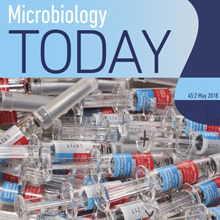Microbiology Today May issue: Microbial Tools
15 May 2018

In this issue, Microbiology Today focuses on the use of micro-organisms as tools in a wide range of contexts. Throughout our feature articles, there is an emphasis on the beneficial ways in which microbes can be utilised, in areas as diverse as construction, pest control and the disposal of radioactive waste.
Timothy Hoffmann, Bianca Reeksting, Richard Cooper, Kevin Paine and Susanne Gebhard start by looking at how bacteria can act as ‘bioengineers’ in the world of construction. After explaining the problems associated with the formation of micro-cracks in concrete, the University of Bath team describe how bacteria that promote the precipitation of mineral carbonates could be used to produce self-healing alternatives.
In their article, Simon Gregory and Megan Barnett explore the potential roles bacteria might play in the disposal of radioactive waste. They highlight the remarkable ability of bacteria to survive high levels of radiation, high temperatures and hyperalkaline conditions, before looking at the possible implications this has for underground repositories of radioactive waste.
Next, Nigel Temperton’s article explains how the creation of retroviral pseudotype viruses (PVs) has reduced the cost and safety issues involved in the development of vaccines, antivirals and therapeutic antibodies, looking in detail at how they are being used in influenza research. The use of micro-organisms as an alternative to chemical pesticides is then discussed by Miranda Whitten and Paul Dyson in their article. In addition to the techniques that have already been widely employed, specifically the use of transgenic crops that express Bacillus thuringiensis toxin, Miranda and Paul offer insights into how bacteria-mediated RNA interference (RNAi) could be used in insect pest control.
Jonathan Welsh, Helen Young, Ruth Stephen and Sam Laurel Stephen focus on gene therapy, which uses viruses as tools to deliver therapeutic genes to patients. They describe the processes used in the production of viral vectors at the Centre of Process Innovation (CPI), a not-for-profit technology and innovation centre. Finally, Alice Smart questions ‘To patent or not to patent?’ in the Comment piece, providing details on when and how to apply for a patent, as well as a list of dos and don’ts.
The issue also contains updates from our journals, details about the upcoming ECM Forum Summer Conference, our programme of Focused Meetings, and more.
View the latest issue online.
